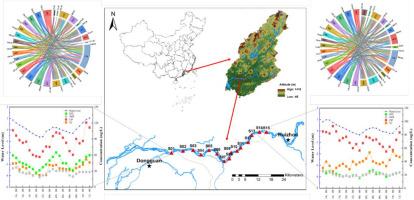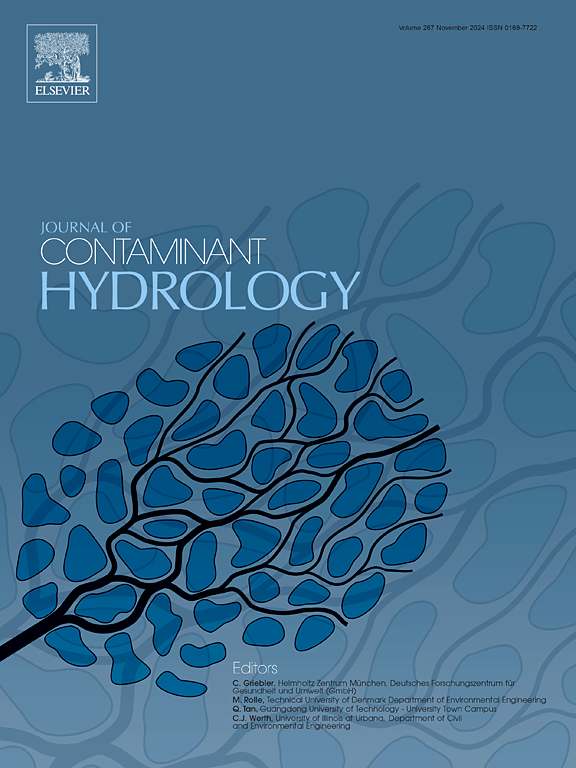Dynamic distribution characteristics and ecological risks of antibiotics in typical subtropical tidal river
IF 4.4
3区 环境科学与生态学
Q2 ENVIRONMENTAL SCIENCES
引用次数: 0
Abstract
Antibiotics have garnered increasing global concern due to their frequent detection and persistence in the environment, which can lead to ecological risks, biological resistance, posing a potential threat to ecosystem and human health. This study investigated the occurrence of antibiotics in a typical tidal channel located in the lower reaches of the Dongjiang River during both wet and dry seasons. Additionally, high-frequency continuous dynamic monitoring was conducted over a full tidal cycle at a tidal-influenced section. The total concentrations of antibiotics ranged from 11.46 to 940.53 ng/L in the wet season and from 15.08 to 322.31 ng/L in the dry season. Fluoroquinolones, particularly ciprofloxacin, were the predominant antibiotics detected. Concentrations were significantly higher in the wet season compared to the dry season. Spatially, antibiotic levels exhibited a pattern with higher concentrations in the upstream and downstream regions and lower concentrations in the middle section. Furthermore, antibiotic concentrations showed a clear tidal influence, with the lowest levels observed during ebb tide and the highest during flood tide. Ecological risk assessment indicated that antibiotics posed higher ecotoxicological risks in the wet season than in the dry season, with fluoroquinolones representing the highest risk category. The potential for antimicrobial resistance was relatively high for ciprofloxacin, moderate for ofloxacin and norfloxacin, suggesting that these compounds should be prioritized in risk management strategies. In contrast, human health risks associated with antibiotic exposure were found to be negligible. These findings offer valuable insights into the behavior and management of antibiotic pollution in tidal rivers.

典型亚热带潮汐河流抗生素动态分布特征及生态风险
抗生素因其在环境中被频繁发现和持续存在而日益引起全球关注,这可能导致生态风险、生物耐药性,对生态系统和人类健康构成潜在威胁。本研究调查了东江下游典型潮汐通道干湿季节抗生素的发生情况。此外,在潮汐影响段进行了一个完整潮汐周期的高频连续动态监测。雨季抗生素总浓度为11.46 ~ 940.53 ng/L,旱季抗生素总浓度为15.08 ~ 322.31 ng/L。检出的主要抗生素为氟喹诺酮类药物,尤其是环丙沙星。雨季的浓度显著高于旱季。从空间上看,抗生素水平呈现上下游浓度较高,中部浓度较低的格局。此外,抗生素浓度有明显的潮汐影响,退潮时最低,涨潮时最高。生态风险评估表明,抗生素在雨季的生态毒理学风险高于旱季,其中氟喹诺酮类药物的风险最高。环丙沙星的耐药潜力相对较高,氧氟沙星和诺氟沙星的耐药潜力中等,提示在风险管理策略中应优先考虑这些药物。相比之下,与抗生素接触有关的人类健康风险被发现可以忽略不计。这些发现为潮汐河流中抗生素污染的行为和管理提供了有价值的见解。
本文章由计算机程序翻译,如有差异,请以英文原文为准。
求助全文
约1分钟内获得全文
求助全文
来源期刊

Journal of contaminant hydrology
环境科学-地球科学综合
CiteScore
6.80
自引率
2.80%
发文量
129
审稿时长
68 days
期刊介绍:
The Journal of Contaminant Hydrology is an international journal publishing scientific articles pertaining to the contamination of subsurface water resources. Emphasis is placed on investigations of the physical, chemical, and biological processes influencing the behavior and fate of organic and inorganic contaminants in the unsaturated (vadose) and saturated (groundwater) zones, as well as at groundwater-surface water interfaces. The ecological impacts of contaminants transported both from and to aquifers are of interest. Articles on contamination of surface water only, without a link to groundwater, are out of the scope. Broad latitude is allowed in identifying contaminants of interest, and include legacy and emerging pollutants, nutrients, nanoparticles, pathogenic microorganisms (e.g., bacteria, viruses, protozoa), microplastics, and various constituents associated with energy production (e.g., methane, carbon dioxide, hydrogen sulfide).
The journal''s scope embraces a wide range of topics including: experimental investigations of contaminant sorption, diffusion, transformation, volatilization and transport in the surface and subsurface; characterization of soil and aquifer properties only as they influence contaminant behavior; development and testing of mathematical models of contaminant behaviour; innovative techniques for restoration of contaminated sites; development of new tools or techniques for monitoring the extent of soil and groundwater contamination; transformation of contaminants in the hyporheic zone; effects of contaminants traversing the hyporheic zone on surface water and groundwater ecosystems; subsurface carbon sequestration and/or turnover; and migration of fluids associated with energy production into groundwater.
 求助内容:
求助内容: 应助结果提醒方式:
应助结果提醒方式:


